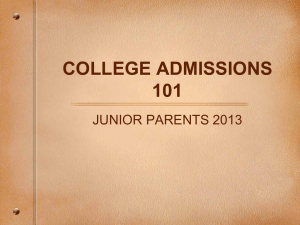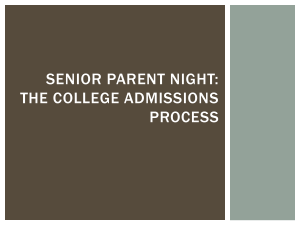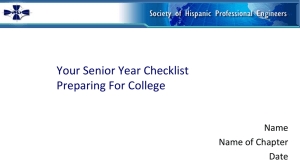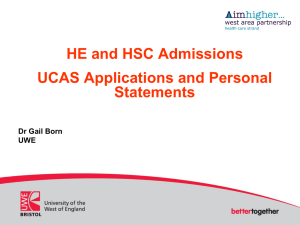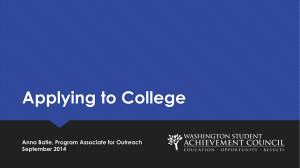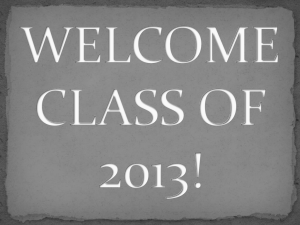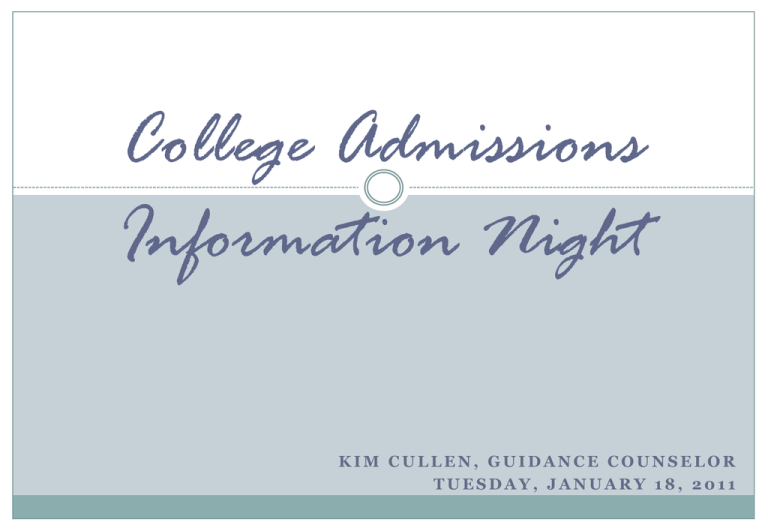
College Admissions
Information Night
KIM CULLEN, GUIDANCE COUNSELOR
TUESDAY, JANUARY 18, 2011
Guidance Office/College Counseling
Kim Cullen
Upper School Guidance and College Counselor
kimcullen@asmadrid.org
Anna Pointing
Upper School Guidance Secretary, CAS Coordinator
UCAS support
annapointing@asmadrid.org
Juan Ortiz
Director Técnico (Selectividad, LOGSE)
juanortiz@asmadrid.org
Purpose of tonight’s presentation
Preview the college admissions process
Get students to start thinking about where you might like to go to
college, and what you might like to study
Encourage parents and students to begin working with the
Guidance Office on college-career plans
Answer questions
The importance of “fit”
Fit is defined in college counseling as the degree to which
the student and their choice of university “match”.
As a college-preparatory school ASM Guidance Office
focuses on helping to identify those colleges or
universities that most closely match the individual
student’s interests, needs, abilities, and potential.
Finding the right fit will enable you to take full advantage
of your university experience.
Ask Yourself
Do you want to go to college?
Why?
What do you hope to gain – personally and professionally?
How do you learn best?
Do you want to study anything that requires special
facilities or programs?
What are your extracurricular interests/needs?
Characteristics of US Colleges: types
University vs. College (larger research based institution with
both undergraduate and graduate programs versus smaller
undergraduate institution)
Liberal Arts College (general knowledge and intellectual skills
versus professional skills)
Junior College (2 year college, leading to an Associate’s Degree
versus a 4-year college, leading to a Bachelor’s Degree – in
Spain: diplomatura versus licenciatura)
Characteristics of US Colleges: types
Engineering or Technical College (those that focus on
scientific or technical professional programs)
Specialty Schools (for example):
Nursing
Military
Hotel Administration/Tourism
Business
Special interest groups (Historically Black Colleges &
Universities; single sex schools)
Characteristics: size
Small: usually under 2,500 students
Medium: generally 2,500 to 10,000 students
Large: any campus over 10,000 students.
Characteristics: selectivity
When choosing where to apply, you must face the
toughest question of all:
Will the college choose you?
Assess your own academic record and the colleges
statistics.
Examine different levels of selectivity: most selective,
highly selective, very selective, selective and other
Characteristics: selectivity
Most Selective:
Highly Selective:
Accepted students have:
“A” average
SAT scores between 625
and 800
Accepted students have:
“B+” to “A” average in most
difficult classes
SAT scores between 575 and
625
Admissions rates under 25%
Admissions rates between
25% and 50%
Characteristics: selectivity
Very Selective:
Accepted students have:
• No grade lower than a B- in
any course
• SAT scores between 525 and
575
Admissions rates between
50% and 75%
Selective, Less Selective, and
Non-Selective
Where to apply?
It is important to give yourself options.
“Reach” or “Dream” Schools
Colleges where your chances of admission are less than 50/50
“Probable” or “Likely” Schools
Colleges that possess the significant features you desire and at
which the probability of admission is 50/50 or better
“Prudent” or “Safer” Schools
Colleges that have most of the features you desire and at which
the probability of admission is “highly likely” to “certain”. It is
important that you would be willing to attend one of these
schools.
Where to apply? How many?
ASM average: 5-6 per student
Range: 1-19
Optimum: max 10
It is recommended that you apply to +/- 3 in each of the following
categories:
“Reach/Dream” – 2/3
“Probable/Likely” – 4/5
“Prudent/Safer” - 3
Ideally, students will be in a position where they can choose.
The College Search Process
Catalogs in Guidance Office
Online
www.asmadrid.org/guests/departments/guidance/guidance_home.htm
www.collegeboard.com
www.princetonreview.com
www.usnews.com/usnews/edu/college/rankings/rankindex_brief.php
www.petersons.com
https://connection.naviance.com
The College Search Process
Alumni Network
College Connections Program
•
•
Allows ASM student to contact ASM alumni at many different
colleges and learn more from the unique perspective of the
ASM graduate.
http://www.asmadrid.org/alumni/subpages/programs.htm#
COLLEGE_CONNECTION_PROGRAM
College Q&A Alumni Panel Program
The College Search Process
College Visits
Visits to ASM from college representatives
Visits to college campuses
There are organizations that offer tours, such as The Princeton Review, and
www.College-Visits.com, www.tscollegetours.com, www.campusbound.com *
Virtual Tours
www.campustours.com free online
www.ecampustours.com free online
www.collegiatechoice.com (walking tours, 15$ per video)
Creating the college list
It is recommended that juniors give themselves an extra
hour of homework each week to research and explore the
different options.
Once you have done your research, you’ll most likely find
that a number of schools meet your needs and interests.
You may have a top choice or two, but chances are, there
will be a group of schools that will “fit the bill”.
What do colleges look at?
Transcript
Quality of student’s course selection
Quality of high school program
Semester grades and grade point average
Short answers and essays
Activities and interests
Give universities an idea of how a student presents him/herself
Recommendation letters
Typically English/Math, also Humanities/Science
Counselor recommendation helps put a student into context
Standardized test scores (if applicable)
How they compare with the typical profile of accepted students
Standardized Testing
Colleges have different ways of assessing a student’s performance and potential.
Standardized testing is ONE of these.
SAT Reasoning:
Measures aptitude and potential
SAT Subject:
Many schools require three SAT Subject tests
(Literature, Biology, Chemistry, Physics, Math levels 1 and 2,
US History, World History, French, Spanish, German,
Modern Hebrew, Latin, Italian, Chinese, Japanese, Korean)
ACT:
Curriculum-based; measures actual learned knowledge
TOEFL:
Test of English as a Foreign Language – required of
international students by a large number of universities
Standardized Testing – Which test?
Different philosophies:
Some colleges have made standardized testing optional
Some will not require SAT or ACT if you submit SAT Subject Tests
Most will give you a choice: SAT or ACT.
Some scholarship programs will require specific SAT or ACT.
Most importantly – check each college’s individual requirements
For information on which schools are SAT/ACT optional, see:
www.fairtest.org/university/optional
For information on the differences between the ACT and SAT exams, see the following
link:
http://www.asmadrid.org/guests/guidance/resources.htm
Standardized Testing – the TOEFL
If English is not your first language, then you should take the
Test of English as a Foreign Language (TOEFL) – even if you are
taking IB English HL.
Students are encouraged to take the TOEFL before the end of 11th
grade. This will take off some of the pressure in 12th grade.
Register at www.ets.org/toefl
Standardized Testing – Testing Prep?
Consider the following:
Is the university testing optional?
How selective is the university?
How did you do on the PSAT?
Add a “0” to your PSAT score to get a rough idea of how you would do on the SAT
50/50/50 on the PSAT would be more or less equivalent to 500/500/500 on the SAT
Several options:
ASM-based SAT Prep course – Alpha Review
Spring session leads to May exam – will begin on March 8 (more information to
come).
Fall session is intensive and leads to October exam.
Outside testing/prep course – e.g. Kaplan online, private tutoring,
www.actstudent.org
Standardized Testing Dates
ACT
June 11, 2011
October 22, 2011
December 10, 2011
February 11, 2012
April 14, 2012
SAT
May 7, 2011
June 4, 2011
October 1, 2011
November 5, 2011
December 3, 2011
January 28, 2012
Final note on standardized testing
HOW MANY TIMES CAN I TAKE THE SAT?
No more than 4 times, typically 2 Reasoning tests and 3 different Subject tests taken
only once each.
WHICH SCORES WILL THE COLLEGES SEE?
Default: All scores for all sittings are sent, and colleges will pick the highest in each
sitting for each subject area
e.g.
May 09
590 CR 650 M 630 Wr
Oct 09
650 CR 620 M 680 Wr
Score Choice: Allows you to select the scores from a particular test date
e.g.
May 09
590 CR 650 M 630 Wr
Oct 09
650 CR 620 M 680 Wr
Admissions Plans - USA
Regular Decision
Most common plan. Apply in December/January, decisions are generally issued end
March/early April.
Early Decision
BINDING agreement between the student and school. Students admitted under this plan
are obligated to attend and MUST withdraw all other applications. Apply by 1
November, decisions issued mid December.
Early Action/Priority
This is a non-binding plan which allows students to keep other applications active. Apply
by 1 or 15 November, decisions issued mid December.
Rolling Admission:
Universities will accept applications at any time and will review candidates based on
space available. Admissions decisions are generally issued 6 to 8 weeks after receipt of
application.
Financial Aid - USA
Financial Aid is money for education that comes from sources
other than the family. It is meant to supplement what the family
can contribute.
Merit-Based
Aid given to a student in form of grants and scholarships and is typically
based on performance/talent.
Need-Based
Aid made available to families who cannot pay all of the post-secondary
education costs on their own. Frequently includes loans and work-study
opportunities.
Financial Aid - USA
For U.S. universities, Federal Financial Aid is available to U.S. Citizens
and green card holders.
The important forms are:
The FASFA (Free form for Federal Student Aid) - www.fafsa.ed.gov
CSS/Profile - www.collegeboard.com
Applications for Financial Aid for students attending university in fall
2012 can be filed no earlier than January 1, 2012.
U.S. Federal Tax return (1040) is required for financial aid.
International Financial Support - USA
Financial aid for international students is not as readily available,
but it is not impossible.
International students apply for aid directly to the
college/university.
International applicants must demonstrate their ability to pay all
tuition, fees and living expenses for the first year of study.
If you require financial aid – do your research and find out which
schools have money for international students.
For more information on financial aid for international students,
see ASM’s Guidance website.
Calendar & Important Dates
Spring Junior Year:
Set up a college-appropriate email address (yourname@email.com)
Schedule appointment with College Counselor to discuss plans Feb/March
Standardized Test Preparation?
Attend Naviance and UCAS workshops (spring)
Register for April ACT and/or May & June SAT tests
Consider a summer program alternative to the beachside/poolside summer http://www.internationalcounselor.org/summer2/Summer_Omnibus/Omn
ibus.html
If you are an athlete or performer, see the College Admissions Handbook
for specific details on what you can be doing this semester to plan ahead.
Calendar & Important Dates
During Summer Vacation:
• Visit colleges, if possible.
• Finish IB Extended Essay.
• Fill out one college application a week for each school to which you plan to
apply. This makes your senior year MUCH easier!
Fall 2011:
College Application Presentation in September (usually 2nd week of school)
Meet with counselor to begin to finalize plans
Take the SAT in October/November or ACT in December
Work on applications!
Last but not least…
BE AWARE OF DEADLINES
App deadlines – US/Canada
• Early deadlines – November
1, 15
• Regular deadlines – usually
12/31-1/1 or early February
• Watch for ASM deadlines
App deadlines – UK
• Early deadlines – 10/15 for
Oxford, Cambridge, Medical
Specializations
• Regular deadlines – usually
end December/early January
• Watch for ASM deadlines
Standardized Testing deadlines for US and UK
SAT/ACT/TOEFL registration deadlines.
UKCAT/BMAT/LNAT/HAT, IELTS, etc.
British Universities
Great option for European Citizens
Costs: As a EU Citizen, tuition & fees are equal to those of
British citizens.
Proximity: Most British Universities are easily accessible by
rail or bus to international airports.
UCAS
What is UCAS?
University and Colleges Admission Service: The central
application service for full-time undergraduate courses in the
United Kingdom.
All students applying to the UK must apply via UCAS
www.ucas.com
UCAS allows students to apply to 5 different universities or
programs with a single application.
Oxbridge → Oxford and Cambridge
Application Deadline:
October 15th: Deadline for applications to Oxford or Cambridge.
Students apply to Oxford or Cambridge through UCAS.
In addition,
Oxford applicants must fill out a separate Oxford application card.
Cambridge applicants need to fill out a Preliminary application form.
Students may not apply to both Oxford and Cambridge
Specializations in the UK
Medicine (including dentistry and
veterinary) - deadline October 15
Law – students must take the LNAT
http://www.lnat.ac.uk/preparation/prac
Because of the early deadlines students
tice.html
need to research their university choices
carefully and make note of all
registration deadlines for testing.
Students interested in the medical fields
must sit the BMAT and/or the UKCAT –
see UCAS website for information
specific to each university
http://www.bmat.org.uk/index.html
http://www.ukcat.ac.uk/
History at Oxford – students must take
the HAT
http://www.history.ox.ac.uk/prosunderg
rad/applying/hat_introduction.htm

